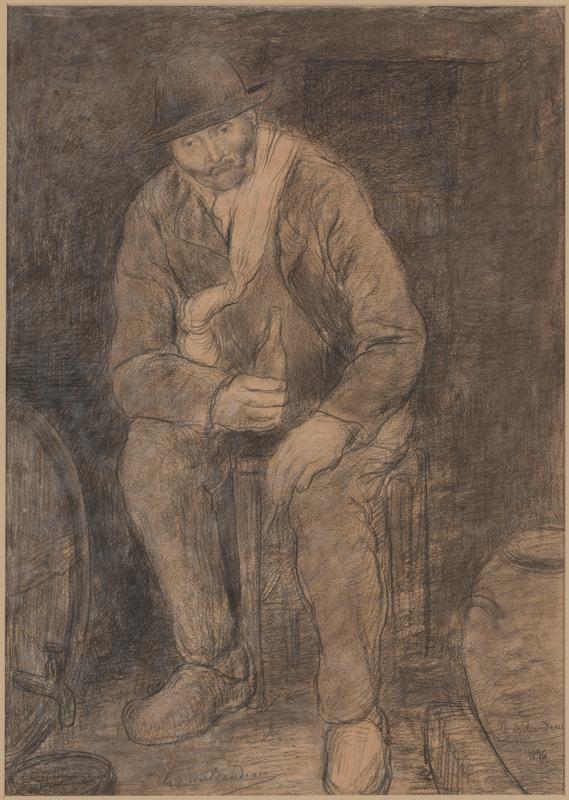
129. Charles Milcendeau, Beggar with a Bottle
| Artist | Charles Milcendeau, French, Soullans, Vendée 1872–Soullans, Vendée 1919 |
| Title, Date | Beggar with a Bottle (Mendiant à la bouteille), 1896 |
| Medium | Charcoal on brown paper |
| Dimensions | 17 11/16 × 12 9/16 in. (45 × 32 cm) |
| Inscriptions + Marks | Lower left: Ch. Milcendeau | Lower right: Ch. Milcendeau / 1896 |
| Provenance | Sale, Hôtel Drouot, Paris, February 28, 1936, no. 27, as “L’Homme à la bouteille.” [Galerie Talabardon, Paris]; Mr. and Mrs. Bradley Radichel, Minneapolis, until 2012; their gift to Yvonne and Gabriel Weisberg, Minneapolis |
| Exhibition History | "Exposition Charles Milcendeau," Galerie E. Druet, Paris, January 22–February 2, 1923, no. 69; "Exposition rétrospective Charles Milcendeau 1872–1919: Peintures, dessins, gouaches, pastels, aquarelles," Galeries Georges Petit, Paris, February 13–28, 1928, no. 66; "Trente ans d’art indépendant 1884–1914: Exposition rétrospective des oeuvres des membres inscrits au cours des trente premières expositions de la Société," Société des Artistes Indépendants, Grand Palais des Champs-Elysées, Paris, February 20–March 21, 1926, no. 3086; "Reflections on Reality: Drawings and Paintings from the Weisberg Collection," Mia, 2022–23 |
| References | Édouard Sarradin, "Charles Milcendeau (1872–1919)," "Gazette des Beaux-Arts" (March 1923), pp. 174–75, ill. |
| Credit Line | Promised gift of Gabriel P. and Yvonne M.L. Weisberg, Minneapolis |
This drawing is among several that Charles Milcendeau did of wanderers and beggars. Such people were always part of French society but perhaps more ubiquitous during the 1890s, when many inhabitants were without work. Because these figures were so visible in the French countryside, artists embraced them as ready models.1 This was especially true for Milcendeau, who grew up in the village of Soullans, where his father ran an inn.
This figure sits on a low stool, possibly hoping to fill his bottle from the barrel next to him. It appears from his expression that this is not his first drink of the day. He also has the look of someone contemplating life’s difficulties. The cloth draped over his shoulder could be a sack containing his possessions, or something to keep him warm when he sleeps. Milcendeau and other realists who depicted such subjects were not necessarily commenting on issues, such as drunkenness or vagrancy, but rather wanted to record what they saw. These artists acted almost as journalists, describing social problems by portraying scenes they encountered.
GPW
Notes
See Gabriel P. Weisberg, “Paul Blanc’s Beggars: Mendicity as Metaphor,” in Second Impressions: Modern Prints and Printmakers Reconsidered, ed. Clinton Adams, vol. 16 of the Tamarind Papers, Tamarind Institute (Albuquerque: University of New Mexico Press, 1996), pp. 13–25. ↩︎